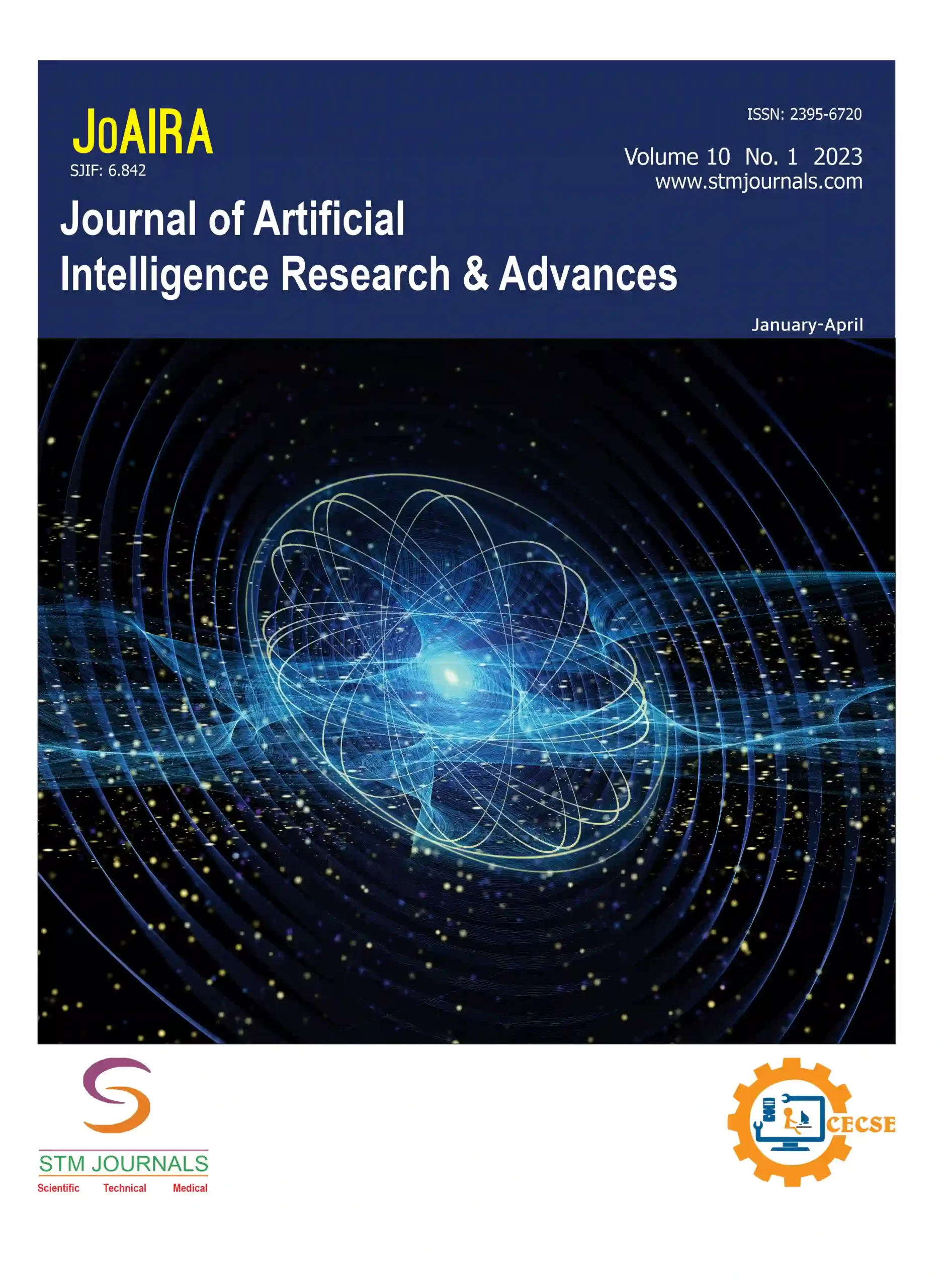[{“box”:0,”content”:”[if 992 equals=”Open Access”]
Open Access
n
[/if 992]n
n
n
n
n
- n t

n
Jhumi Thapa, Anshu Ghimire
[/foreach]
n
n
n[if 2099 not_equal=”Yes”]n
- [foreach 286] [if 1175 not_equal=””]n t
- Assistant Professor, Assistant Professor, Department of Computer Science and Engineering1,2 Nepal Engineering College, Department of Computer Science and Engineering1,2 Nepal Engineering College, Bhaktapur, Bhaktapur, Nepal, Nepal
n[/if 1175][/foreach]
[/if 2099][if 2099 equals=”Yes”][/if 2099]nn
Abstract
nBreast Cancer is the most common type of cancer seen in women on present days, which is also considered as life threating disease. If this cancer can be detected on its early stage it can be life saver for many people around the world. Machine Learning techniques has become one of the hotspots for predicting early diagnosis of breast cancer. This research work experiments with the two most popularly used Supervised Machine Learning Algorithms, K-Nearest Neighbor, and Artificial Neural Network which will detect breast cancer by training its attributes and to find out the most effective with respect to confusion matrix, accuracy, and precision. The findings indicate that the Artificial Neural Network Machine achieved superior performance, outperforming all other classifiers with an accuracy rate of 98%. All the work are done on python programming language using Scikit-learn library and tensor flow.
n
Keywords: K-Nearest Neighbors (KNN), Artificial Neural Network (ANN), breast cancer, machine learning, prediction, Fine Needle Aspirate (FNA)
n[if 424 equals=”Regular Issue”][This article belongs to Journal of Artificial Intelligence Research & Advances(joaira)]
n
n
n
n
n
n
n[if 992 equals=”Open Access”] Full Text PDF Download[/if 992] nn
n[if 379 not_equal=””]nBrowse Figures
n
n
n[/if 379]n
References
n[if 1104 equals=””]n
- Different Kinds of Breast Lumps | Stony Brook Cancer Center. Stonybrookmedicine.edu. 2023. Available from: https://cancer.stonybrookmedicine.edu/breast-cancer-team/patients/bse/breastlumps
- Verma A, Kumar A, Kumar MS. Breast cancer prediction using support vector machine. International Research Journal of Engineering and Technology (IRJET). 2019.
- Alanazi SA, Kamruzzaman MM, Sarker MN, Alruwaili M, Alhwaiti Y, Alshammari N, Siddiqi MH. Boosting breast cancer detection using convolutional neural network. Journal of Healthcare Engineering. 2021;2021.
- Eyupoglu C. Breast cancer classification using k-nearest neighbors algorithm. The Online Journal of Science and Technology. 2018;8(3):29-34.
- UCI Machine Learning. Breast Cancer Wisconsin (Diagnostic) Data Set. Kaggle.com. 2016. Available from: https://www.kaggle.com/datasets/uciml/breast-cancer-wisconsin-data
- Kalyani Wadkar, P. P. (2019). BREAST CANCER DETECTION USING ANN NETWORK AND PERFORMANCE ANALYSIS. International Journal of Computer Engineering & Technology (IJCET), 75-86.
- Tahmooresi M, Afshar A, Rad BB, Nowshath KB, Bamiah MA. Early detection of breast cancer using machine learning techniques. Journal of Telecommunication, Electronic and Computer Engineering (JTEC). 2018 Sep 26;10(3-2):21-7.
- Bakthavachalam MD, Raj DS. A Study Of Breast Cancer Analysis Using K-Nearest Neighbor With Different Distance Measures And Classification Rules Using Machine Learning. European Journal of Molecular & Clinical Medicine. 2020;7(3):4842-51.
- Milon Islam, H. I. (2017). Prediction of Breast Cancer Using Support Vector Machine and K-Nearest Neighbors . 2017 IEEE Region 10 Humanitarian Technology Conference (R10-HTC), 226-229.
- Breast cancer. Who.int. World Health Organization: WHO; 2024. Available from: https://www.who.int/news-room/fact-sheets/detail/breast-cancer
- Shagun Chawlaa, R. K. (2018). Breast Cancer Detection Using K-Nearest Neighbour Algorithm. Proceedings of International Conference on Computational Intelligence and Internet of Things 2018 (pp. 799-805). New Delhi: G.B EngineeringCollege.
- Shler Farhad Khorshid, A. M. (2021). BREAST CANCER DIAGNOSIS BASED ON K-NEAREST NEIGHBORS: A REView. PalArch’s Journal of Archaeology of Egypt/Egyptology, 1927-1951.
- Singhal V, Chaudhary Y, Verma SK, Agarwal U, Sharma MP. Breast Cancer Prediction using KNN, SVM, Logistic Regression and Decision Tree. 2022;10(5):1877-1881.
nn[/if 1104][if 1104 not_equal=””]n
- [foreach 1102]n t
- [if 1106 equals=””], [/if 1106][if 1106 not_equal=””],[/if 1106]
n[/foreach]
n[/if 1104]
nn
nn[if 1114 equals=”Yes”]n
n[/if 1114]
n
n

n
Journal of Artificial Intelligence Research & Advances
n
n
n
n
n
n
| Volume | 11 | |
| [if 424 equals=”Regular Issue”]Issue[/if 424][if 424 equals=”Special Issue”]Special Issue[/if 424] [if 424 equals=”Conference”][/if 424] | 01 | |
| Received | January 14, 2024 | |
| Accepted | April 9, 2024 | |
| Published | April 24, 2024 |
n
n
n
n
n
nn function myFunction2() {n var x = document.getElementById(“browsefigure”);n if (x.style.display === “block”) {n x.style.display = “none”;n }n else { x.style.display = “Block”; }n }n document.querySelector(“.prevBtn”).addEventListener(“click”, () => {n changeSlides(-1);n });n document.querySelector(“.nextBtn”).addEventListener(“click”, () => {n changeSlides(1);n });n var slideIndex = 1;n showSlides(slideIndex);n function changeSlides(n) {n showSlides((slideIndex += n));n }n function currentSlide(n) {n showSlides((slideIndex = n));n }n function showSlides(n) {n var i;n var slides = document.getElementsByClassName(“Slide”);n var dots = document.getElementsByClassName(“Navdot”);n if (n > slides.length) { slideIndex = 1; }n if (n (item.style.display = “none”));n Array.from(dots).forEach(n item => (item.className = item.className.replace(” selected”, “”))n );n slides[slideIndex – 1].style.display = “block”;n dots[slideIndex – 1].className += ” selected”;n }n”}]

